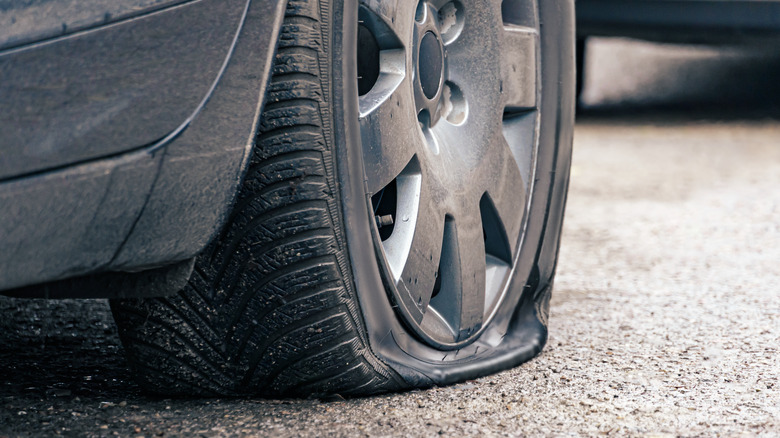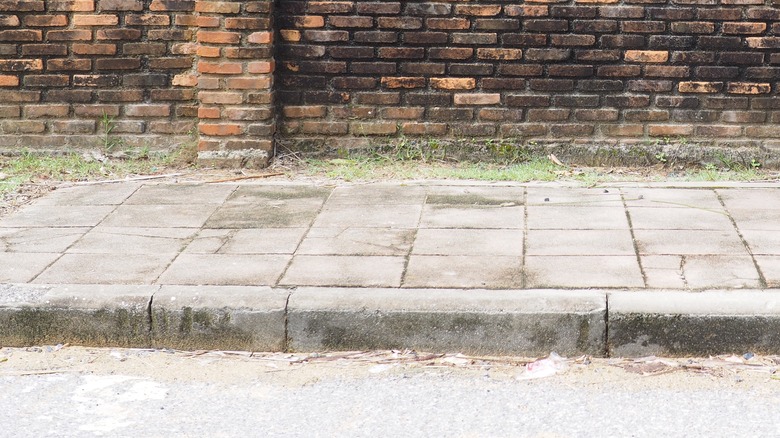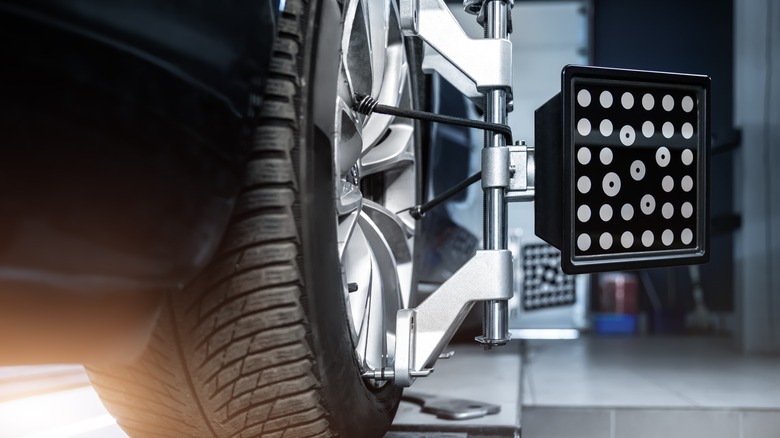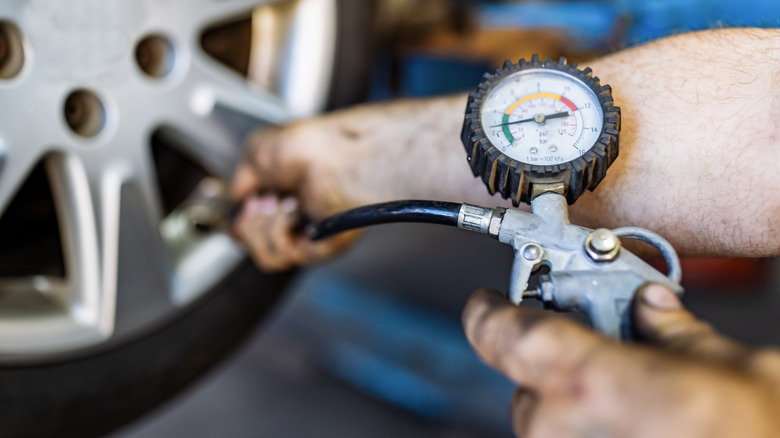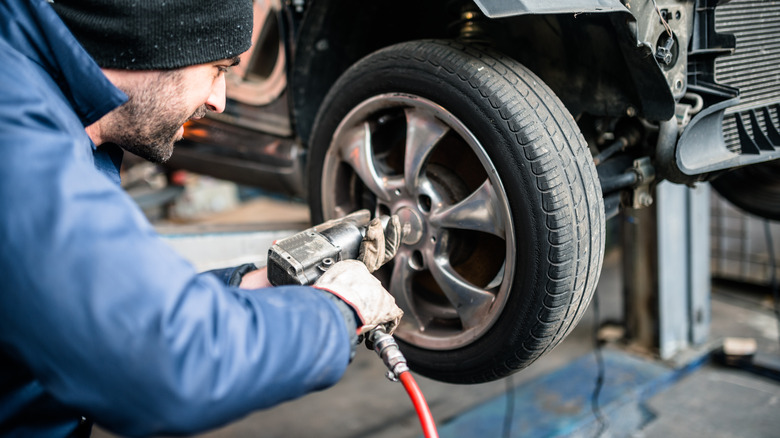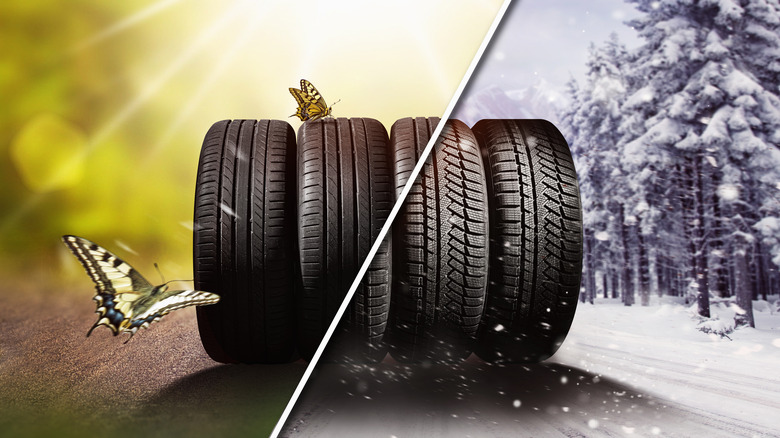Terrible Habits That Are Slashing The Life Of Your Tires Fast
Tire replacements are a part of vehicle ownership. Your car's tires will wear out sooner or later, and when they do, you'll likely be spending hundreds of dollars on new rubber. Still, this should be an expense you'll only encounter every few years. Good quality tires can last up to five years or up to 75,000 miles if properly taken care of. Even cheaper tires or retreads should last over three years on average. If you find yourself heading to the tire shop annually, you're either pretty unlucky or something is going wrong.
Sometimes, you just have bad luck and can't prevent tire loss. You may hit a broken bottle or other road hazard, damaging your tire beyond repair. But some tire damage is preventable, and a little care can save you hundreds of dollars worth of unnecessary expenses. Obviously, you shouldn't be driving aggressively, flying into corners, and performing burnouts if you want your tires to last beyond the warranty phase — but some damaging actions are a little less obvious. Here are five things you should avoid to get as much mileage as possible from your vehicle's tires.
Hitting the curb
If you're in an area with a particularly tight turn and a lot of traffic, like a fast food drive-thru, you may spot a piece of the curb with some notable gouges and a good coating of rubber. This comes from the long line of drivers that haven't left enough room and have caught said curb on the way around. Maneuvers like parallel parking can also result in tires meeting the curb if a driver isn't careful enough.
While grazing a curb at low speed isn't great for a tire, or the rim it's attached to, a one-off incident isn't likely to cause problems. Curbing a vehicle multiple times or meeting the edge of the pavement at high speed is a different story. Some tires are better suited to deal with curbing than others. A fat truck tire has more material to grind through than the low-profile set of boots on a performance car — but it's worth avoiding no matter what you're driving.
Curbing a vehicle damages the tire's sidewall, and that's one of the worst things you can do to your rubber. If you run over a nail, your tire may be punctured, which can be easily and cheaply fixed. Sidewall damage is a serious issue, and it's not something that can be repaired. It can lead to a blowout, and if it's more than a mild graze, it will likely result in you purchasing a new tire.
Ignoring alignment issues
If your wheels are out of whack, you may find yourself going through tires very fast. Vehicle collisions, road hazards like curbs or potholes, and failing suspension parts can cause alignment problems.
The easiest way to spot an alignment issue is to check the surface of your tires. If the tire surface is wearing unevenly, this strongly indicates an alignment issue. Other telltale signs can include the vehicle pulling to one side, your steering wheel not being straight when going forward, and the ride becoming noticeably shaky at speed.
Unfortunately, wheel alignment isn't one of those things you should be fixing yourself. Yes, you can get things close with some string, dish soap, and a couple of garbage bags — but if you want your tires aligned correctly, you really need to go to a shop. Tire shops have hundreds of thousands of dollars worth of specialist equipment, ensuring the tires are aligned precisely as required. Professionals also won't overlook steps like adding a little positive toe to the front wheels to increase stability. Aligning the wheels is also more complex on newer vehicles.
If you ignore a bad alignment problem, one side of your tire will wear significantly faster. Eventually, this will lead to a blowout. Wheel alignment issues often affect more than one tire, too, so once one wheel blows, it's likely that the opposite tire isn't far behind.
Not checking your tire pressure
Driving on a flat tire will damage said tire beyond repair. Even "run-on flat" tires are only designed to help you limp to a tire shop and must be discarded once you get there. But your car tire doesn't need to be flat to cause problems. A tire with low pressure can still distort, and this causes both increased and uneven wear.
You don't have much of an excuse in a more modern vehicle. Sensors and an onboard computer monitor tire pressure in most cars these days and will alert the driver if the pressure becomes dangerously low. This alert can be a tire pressure warning light or an indication on the HUD. With older vehicles or the few new vehicles without tire pressure sensors, a visual inspection can indicate if a tire is particularly low on air, but you should probably use a tool to check the pressure at least once a week. Alternatively, you can use a pump set to your vehicle's optimal tire pressure and just inflate them to said pressure regularly. Your tires should also be "cold" when you top them up.
The problems don't stop with increased tire wear. Incorrect tire pressure can cause handling issues and increase fuel usage. Uneven tire pressure can also cause a vehicle to drift to one side. To find your car's optimal tire pressures, consult your vehicle's manual or look for the information panel near the driver's door sill or on the fuel cap.
Not rotating your tires regularly
Tire rotation is a simple concept. The vehicle's wheels are swapped to ensure they wear down as evenly as possible. Even if your wheel alignment and tire pressures are perfect, all four wheels will wear at different rates. If your vehicle is front- or rear-wheel drive, the drive wheels will experience more torque and wear faster than the non-drive wheels. Front wheels are also toed in slightly to make the vehicle more stable. This means they will wear slightly unevenly. A tire rotation ensures any discrepancies are balanced and their impact is minimized — extending the life of your vehicle's tires.
Many tire shops rotate your wheels for free when you take your vehicle in for a tire change. Some places also include this service with other routine maintenance like oil changes. However, there are some issues with tire rotation. Tires with directional treads have their benefits, but they mean the tire only works on one side of the car. This limits the mechanic's options when the wheels are being rotated.
Some things may prevent you from having your tires rotated. All four tires should have matching treads, too. Otherwise, vehicle control could be affected. This is less of an issue with a vehicle's back tires, so it will get by as long as a vehicle has at least two matching tires. But if only two tires match, tire rotation may not be an option.
Using the wrong tires for the season
If you live in a climate that sees cold temperatures, snow, and ice for several months of the year, then having a set of winter tires fitted can make a massive difference. Alongside tread differences, winter tires are made from a softer compound than regular and all-season tires. Tires with harder compounds need to hit a specific temperature before they grip to their full potential, while the softer winter tires can provide more grip when the mercury goes below a certain point. This is hugely beneficial in the winter, but if you leave those tires on too long, you will likely destroy them.
The trouble with winter tires outside of winter is two-fold. Firstly, the softer compound isn't as durable as the harder rubbers other tires are made from and will naturally wear down faster. Add in a little heat, and the problem gets worse. Like harder compounds, winter tires will get softer as ambient temperature, direct sunlight, and driving warm them. The softer they get, the quicker they wear, so you should switch them out once the weather breaks if you want to get a few years out of them.
If it gets particularly cold where you are, using normal tires in winter won't make them wear out faster. However, it will increase your chances of getting into an accident — at which point tire wear will probably be the least of your problems.
